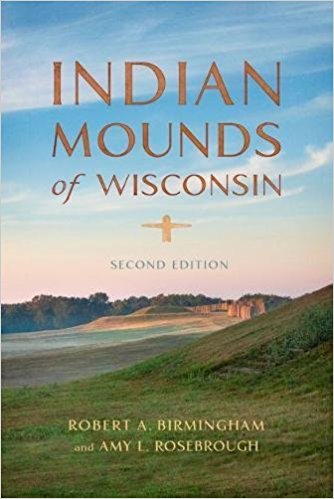
More mounds were built by ancient Native Americans in Wisconsin than in any other region of North America—between 15,000 and 20,000, at least 4,000 of which remain today. Most impressive are the effigy mounds, huge earthworks sculpted in the shapes of thunderbirds, water panthers, and other forms, not found anywhere else in the world in such concentrations. This second edition is updated throughout, incorporating exciting new research and satellite imagery. Written for general readers, it offers a comprehensive overview of these intriguing earthworks.
Citing evidence from past excavations, ethnography, the traditions of present-day Native Americans in the Midwest, ground-penetrating radar and LIDAR imaging, and recent findings of other archaeologists, Robert A. Birmingham and Amy L. Rosebrough argue that effigy mound groups are cosmological maps that model belief systems and relations with the spirit world. The authors advocate for their preservation and emphasize that Native peoples consider the mounds sacred places.
This edition also includes an expanded list of public parks and preserves where mounds can be respectfully viewed, such as the Kingsley Bend mounds near Wisconsin Dells, an outstanding effigy group maintained by the Ho-Chunk Nation, and the Man Mound Park near Baraboo, the only extant human-shaped effigy mound in the world.
Product Details:
Editorial Reviews
Throughout history, the mound-builder societies of the many Native American cultures have captured many people's attention. The indigenous mound-building society in Wisconsin, known as the Ho-Chunk, or Winnebago, and the Ioway people were two of the most prolific in the U.S. Because of the increased requests for information, Birmingham and Eisenberg have completed one of the most comprehensive guides to the mounds of Wisconsin. Previously, none of the information on the mounds or their builders was available in a complete volume. Beginning with Wisconsin's early occupants, this work details 2,000 years of history, from pre-mound-builder groups to the modern era. Throughout the book, there are photographs, maps, and detailed drawings of artifacts, people, and the mounds. Included in the appendix is a listing of mound sites open to the public. Indian Mounds is an important and necessary addition to any collection on Native American cultures and the early history of the Midwest. Julia Glynn
Copyright © American Library Association. All rights reserved --This text refers to an alternate Paperback edition.
"Details 2,000 years of history, from pre-mound-builder groups to the modern era. ... Important and necessary."
—Booklist
"The challenge of explaining Wisconsin's Indian mounds has been met. ... [A] remarkable book." —Historical Geography
About the Author
Robert A. Birmingham is the author of Spirits of Earth: The Effigy Mound Landscape of Madison and the Four Lakes and the coauthor of Aztalan: Mysteries of an Ancient Indian Town. Now retired, he served as the state archaeologist of Wisconsin for many years and received the Increase Lapham Research Medal from the Wisconsin Archeological Society. Amy L. Rosebrough is a Wisconsin archaeologist and the coauthor of Water Panthers, Bears, and Thunderbirds: Exploring Wisconsin's Effigy Mounds.